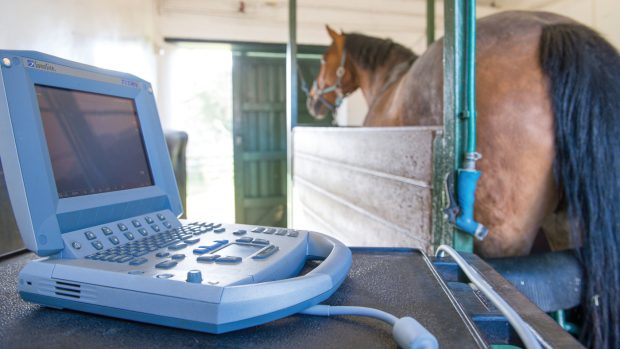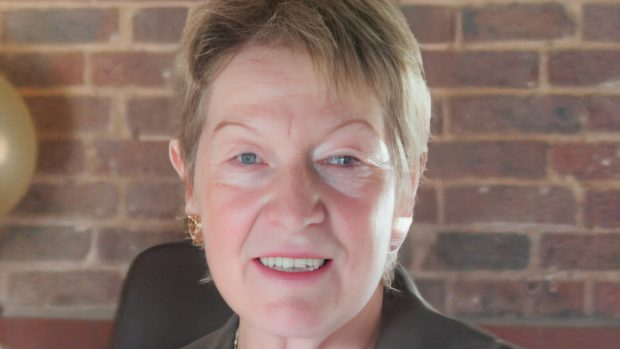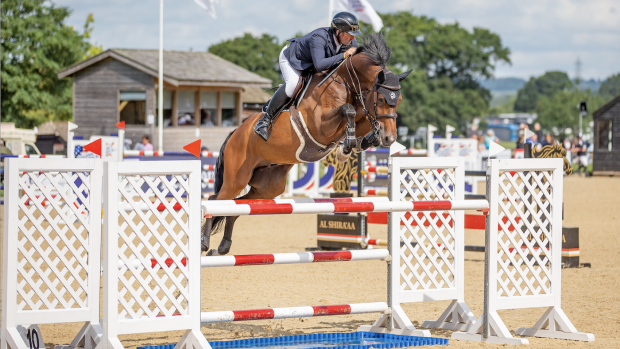In an old Gloucestershire cider orchard, unaware of the accolades, Pastiche grazes quietly. The 20-year-old broodmare, who lives at the enigmatically named Hooze Farm, is the dam of Donnersong (pictured right), the charismatic horse competed by Carl Hester and one of just a handful of British-bred international grand prix dressage stallions.
Pastiche is by Pik Trumpf, a son of Pik Konig, who is also the sire of German rider Herbert Rehbein’s famous grand prix stallion, Pik Bube. Kate Carter bought her in England as an unbroken five-year-old to sell on.
“I was seduced by her looks and fantastic trot,” says Kate. “It was the time when everyone suddenly began importing horses from Germany and I realised that the only way I was ever going to afford one was to breed one. Rather than selling Pastiche, it seemed a good idea to have a foal.”
There was never any doubt about the sire. Fifteen years ago, Karin Rehbein’s now legendary stallion Donnerhall was wowing the crowds in a big way.
“He was my pin-up and I idolised him,” says Kate, who splashed out £600 for just one precious straw of semen — the average British stud fee at the time was £250.
If not the first, Donnersong was certainly one of the earliest sport horse successes to have been conceived in the UK via frozen semen: “It was a gamble and a dream, made more surreal because I always wanted a bay stallion with a white stripe and white socks.”
Seven years later the precocious young Donnersong — obligingly a bay with a white stripe and three white socks — stormed into the British national dressage championships, taking the advanced medium title in his first year of competition.
Kate puts this moment at the top of her “best Donnersong memories”.
“‘Otto’ really tried. He gave of his best and was an outright winner. Everyone was so pleased for the horse and us — it was fantastic.”
Donnersong came into Carl Hester’s life as a bumptious three-year-old when Carl moved to the Carters’ yard in Stow-on-the-Wold. Carl stayed with Kate and her husband Stuart after the move to Hooze Farm, near Tewkesbury, where he now runs his own training business.
“I was the first on him — and the first off,” recalls Carl. “He was pretty wild as a young stallion.”
Despite the antics, Kate vowed never to part with Donnersong.
“British dressage riders were short of horses and I committed Otto to Carl. He was never ever for sale, whatever he achieved — he was my pet and very special. I felt that he had the personality and presence to carry him a long way,” explains Kate, who acknowledges the rider’s part in his success.
“It’s been a team effort, but the relationship between riders and breeders is symbiotic — they need each other.”
Following advice from current Dutch team trainer Bert Rutten, it was decided to prove Donnersong in competition before he was used for covering.
Carl says: “Bert always believed that a stallion should compete up to prix st georges — all his were produced to a good level, so we followed his guidance.”
It was not until he was seven that Donnersong covered his first mare.
“Donnersong always had an amazing canter and showed a lot of potential: we got quite excited by him. We now know that he passes this canter on, as well as his looks,” says Carl, who now trains several of Donnersong’s offspring and their riders.
In 1999, Donnersong’s career looked in doubt when an undiagnosed lameness, which turned into laminitis, kept him out of the arena. Luckily, Donnersong made a full recovery and at the beginning of the following year, Carl and the now 10-year-old won the prix st georges and took six out of seven classes on the Spanish Sunshine Tour. The combination went on to have an outstanding season, winning 12 out of 17 international classes.
In 2001, Donnersong scored his first national grand prix victory and also won what become his speciality class, the grand prix freestyle.
“I always remember Nick Williams saying that he saw ‘shades of Rembrandt [the world-famous freestyle horse]’,” says Carl. “Donnersong was an exciting, beautiful, good-moving performer whom people wanted to watch.”
With Carl now concentrating on Olympic selection with Escapado, Donnersong has now been retired from the competitive arena to concentrate on his stud career.
Carl says: “Doing both isn’t easy and there are a lot of physical demands on a competing breeding stallion — you can’t expect full concentration, particularly when the going gets tough, as it does at the top. He’s competed in international grand prix, is a proven winner and now his stud career is more important.”
|
||
 |
||


 Get up to 19 issues FREE
Get up to 19 issues FREE TO SUBSCRIBE
TO SUBSCRIBE 



